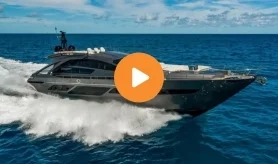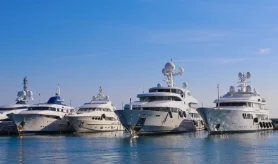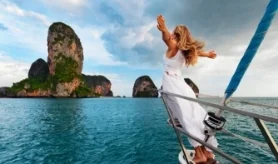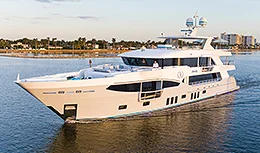- Alaskan Yachts
- Azimut Yachts
- Back Cove Yachts
- Beneteau Yachts
- Benetti Superyachts
- Bertram Yachts
- Boston Whaler
- Broward Yachts
- Buddy Davis Sportfish
- Burger Yachts
- Cabo Yachts
- Catamarans
- Carver Motoryachts
- Center Console
- Chris-Craft Yachts
- Cruisers Yachts
- DeFever Trawlers
- Dufour Sailboats
- Fairline Yachts
- Feadship Yachts
- Ferretti Yachts
- Formula Yachts
- Fountaine Pajot Cats
- Grady-White
- Grand Banks Trawlers
- Hargrave Yachts
- Hatteras Yachts
- Hinckley Picnic Boats
- Horizon Yachts
- Hydra-Sports
- Intrepid Boats
- Jarrett Bay Sportfish
- Jeanneau Yachts
- Kadey-Krogen Trawlers
- Lazzara Yachts
- Lekker Boats
- Luhrs Sportfish
- Marlow Yachts
- Maritimo Yachts
- Marquis Yachts
- McKinna Motoryachts
- Meridian Yachts
- Midnight Express
- MJM Yachts
- Mochi Craft
- Neptunus Motoryachts
- Nordhavn Trawlers
- Nordic Tugs
- Numarine Yachts
- Ocean Alexander Yachts
- Offshore Yachts
- Outer Reef
- Oyster Sailing Yachts
- Pacific Mariner Yachts
- Palmer Johnson Yachts
Journey Maker – Fountaine Pajot Summerland 40 LC
November 19, 2014 8:44 am
The Summerland MY 40 LC is a boat designed for enjoying coastal jaunts with lots of onboard space and cruising efficiency. And she happens to be a power catamaran.
Builder: Fountaine Pajot
Model: Fountaine Pajot Summerland 40 LC
Year: 2014
Boat Type: Catamaran
LOA: 39’3″
Beam: 17’8″
Draft: 3’6″
Base Price: $532,226
The Miami sky was turning from black to the warm blue of morning as the sun began to peek over the horizon. The Miami Boat Show was over and we were leaving, making the way down Indian Creek onboard a new Summerland MY 40 LC powercat, moving quietly in single file with a handful of other boats looking to get an early morning start, resembling a nautical platoon on some pre-dawn patrol. While settled into the after section of the flying bridge’s L-shaped settee, with Capt. James Fachtmann taking us out to Biscayne Bay, a couple things came to mind. First, the sorry recognition that there is virtually nowhere on Collins Avenue to get a coffee at 4:45 in the morning, and second, the fond remembrance of numerous offshore passages made in the past, complete with the gentle hum of an engine and the slap of the sea.
Turns out this is an appropriate feeling when you’re on one of Foutaine Pajot’s powercats. The company, founded in 1976 in La Rochelle, France, by well-known competitive sailor Jean-Francois Fountaine, has been a longtime player in the sailing catamaran market, boats designed to comfortably cruise the world. Since 1998, however, the company has also been building powercats—vessels that were originally branded “Trawler Catamarans” and continue to live up to the name to this day. The ace in the hole for these boats is the living space and stability, thanks to the catamaran design, giving them the same desirable features for coastal cruising that many charter fleets obviously appreciate. And when the anchor goes down, the party starts up, with plenty of room for friends on this wide platform. They also cruise efficiently—is it any wonder catamarans are beginning to get the serious consideration that smart design helps them deserve? The Summerland 40 MY LC is the smallest vessel in the company’s power-cat range (though not for long, see “The Newest Member of the Family,” below) and, as you’d expect, embodies the traits of both a seaworthy, oceangoing trawler, and a well-built, comfortable catamaran.
Her layout is a pleasing one, simple, yet with several shippy elements that remind you this boat is meant to roam. A seamanlike bucket chair (built in-house) sits behind the centerline helm, a command station that would please any skipper. Again, simple, but with everything you need when you decide to cruise without the wind in your hair—a Garmin chartplotter, engine-control levers, Volvo Penta readouts, VHF, and all of your electrics switches. Sightlines were good all around thanks to large windows. There were also plenty of flat surfaces around the helm for a navigator to use paper charts (still an onboard preference for many cruisers), with fiddle-like table-top recesses that help things stay put in a sea. There were also fiddles atop the Elba propane stove in the galley, aft to starboard, in addition to enough counter space and stowage (plenty of cabinets to starboard as well as a stacked set of Isotherm refridgerator/freezer drawers to port) to craft an actual meal.
These seaworthy design touches continued throughout the rest of the boat. The hydraulic steering system on the boat featured a hydraulic backup that would, in the case of an emergency, allow the hydraulic steering pressure to be brought to zero so that the skipper can steer the vessel using an emergency tiller. A smart feature and clearly one that draws on the company’s sailing roots.
Another nice aspect of the Summerland 40 LC is the reassuring amount of equipment that stateside cruisers will find fairly standard—Racor fuel filters, Vetus fuel-water separators, Exide batteries, a Fusion stereo system, a top-of-the-line Victron Energy Multiplus Compact Inverter, a Cummins Onan generator, and more. So whether you find yourself with a chartplotter problem in Canada, or an engine problem in St. Thomas, getting parts and service shouldn’t be too much of an issue and, while the English-French labels on some components are gentle reminders of the boats lineage, you won’t find yourself scratching your head trying to figure out what’s what.
Belowdecks, two queen berths, one forward and one aft of a shared head, fill the port hull, and the starboard hull features a master stateroom worthy of the name and a large head. There is plenty of stowage throughout both areas, in hanging lockers and elsewhere. A “technical room” that can be accessed via a door in the after end of the master head. It was in this well-lit room where the generator, the holding tank (made from just see-through material so you can quickly check the level at a glance), a Vetus fuel-water separator, and the hydraulic pump were housed.
Once we’d dealt with the bridge, as well as all the traffic jams that always seem to accompany leaving a boat show, we made our way across Biscayne Bay to the Miami Beach Marina to fuel up before doing our speed runs in Government Cut. Each hull on our test boat housed a 150-horsepower Volvo Penta D3 diesel installed on beefy, vibration-reducing engine mounts, a PuraFiner diesel filtration unit, a large Exide starting battery (with the main breaker and house batteries in the starboard hull), and nearly 2 inches of SoundDown insulation that keeps the engines whisper quiet while you’re cruising. The areas are fairly spartan, but clean, and well lit. Another design element that points to the seamanlike quality of the Summerland are fiberglass moldings around the engine-room day hatches that keep out the sea but are removable if you need to get down there while you are underway.
Running the Summerland was a real pleasure. That early dawn had turned into a perfect South Florida day, and as we ran her up and down Government Cut to get our speed numbers, that seat at the upper helm station was the only place in Miami I wanted to be. Throughout the entire rpm range the Summerland was quiet and the ride was comfortable, with a maximum running attitude of only 4 degrees at just over 14 knots with the pins down. Her comparatively deep gear ratio of 2.49:1 generates lots of torque, and you can really feel the props bite when you shift into gear, whether forward or astern.
One element of the upper and lower helm that is worth mentioning here is the engine-control binnacle—it was installed at an angle rather than on a level surface. This may trip up a helmsmen, at least until he gets used to the configuration because, when the levers were pointing straight up, the engines were not in neutral, as you might think, but still powering very quietly and stealthily forward. This is a minor design element though, and to help the “straight means neutral” helmsman, Volvo Penta has lights on the binacle that indicate forward, reverse, and neutral.
With the numbers gathered and our fueling and speed runs done, we pointed the boat out of the inlet and into the deep-blue waters of the Florida coast. Seas didn’t amount to much on our test day, but what there was the Summerland handled with ease-—everywhere on the boat the motion was quite comfortable. We put her into the waves, carved some S-turns and figure eights, and pointed her back toward land. And that is the true allure of the Summerland MY 40 LC. She is a boat meant to cruise, like a thoroughbred is meant to run or a Labrador meant to retrieve. She beckons you to leave the harbor, to throw that waypoint on the plotter and just go. Who needs a coffee?
The Newest Member of the Family – Fountaine Pajot MY 37
The Summerland 40 LC is soon to have a new little sister, one that measures around 36 feet. The company has announced that it will be launching the new Fountaine Pajot MY 37 May 2015 in the south of France. This will give the company “A real range of motoryachts,” says Flagship manager Yves de Kerangat, “with four models we will really give an alternative to the monoull motoryacht market.” Could this point the way toward more hulls on more vessels throughout the industry? Only time will tell. But if the Fountaine Pajot powercats are pointing the way to the passagemaking future, that might be a bright future indeed.
For more information, contact Fountaine Pajot Brand Managers:
Denison Florida Wiley Sharp | Wiley@DenisonYachtsSales.com | 561.613.8985
Denison California Dave Millett | D.Millett@denisonyachtsales.com | 714.260.5901
Source: Power & Motoryacht












